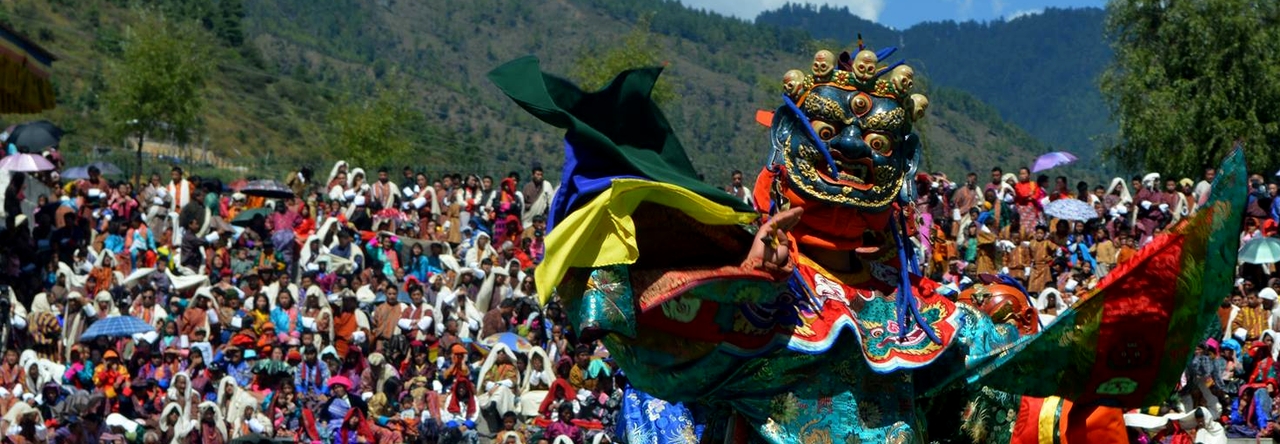Welcome to Bhutan, the Land of the Thunder Dragon. Touching down at Paro International Airport, you will be greeted by your guide upon exiting the arrival hall.
Today, we will take it easy to acclimatize to the altitude. Drive to Thimphu, check in to the hotel.
Day- 1, Thimphu Sightseeing Tour:
National Memorial Chorten
 After lunch drive to National memorial Chorten, this was built in 1974 in honor of the late King JigmeDorjiWangchuk. Throughout the day people circumambulate the chorten, whirl the large red prayer wheels and pray at a small shrine inside the gate. Like the early birds, old aged people go early morning till the dawn to circumambulate and pray the whole day and the students pass by and do around 3 rounds before they leave for their schools. People often go there or whenever they get the time they go there and their stressful mind gets relaxed, because the moment you step your feet inside the gate you feel so peace and becomes more peaceful when you hear the rings of bells.
After lunch drive to National memorial Chorten, this was built in 1974 in honor of the late King JigmeDorjiWangchuk. Throughout the day people circumambulate the chorten, whirl the large red prayer wheels and pray at a small shrine inside the gate. Like the early birds, old aged people go early morning till the dawn to circumambulate and pray the whole day and the students pass by and do around 3 rounds before they leave for their schools. People often go there or whenever they get the time they go there and their stressful mind gets relaxed, because the moment you step your feet inside the gate you feel so peace and becomes more peaceful when you hear the rings of bells.
Buddha Statue: 51M tall.
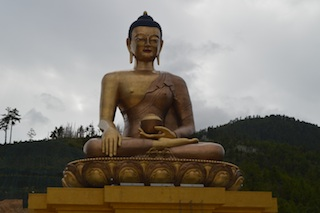 Buddha Statue – one and the only biggest Buddha (51M) tall statue built on top of the Kuensel Phodrang 50m tall over looking on the top of the Thimphu town. People over call it as a Buddha Point. The best part is when you reach up there you can see the whole Thimphu town, if you get a chance to go up there at night you could see the street lights on and through that street lights we could see Thimphu town in a crown shape of our King, and It’s really beautiful that you can’t get your eyes off.
Buddha Statue – one and the only biggest Buddha (51M) tall statue built on top of the Kuensel Phodrang 50m tall over looking on the top of the Thimphu town. People over call it as a Buddha Point. The best part is when you reach up there you can see the whole Thimphu town, if you get a chance to go up there at night you could see the street lights on and through that street lights we could see Thimphu town in a crown shape of our King, and It’s really beautiful that you can’t get your eyes off.
Changangkha Monastery
 Changangkha Lhakhang – Visit to Changangkha Lhakhang, it was established in the 12th century on a site chosen by Lama Phajo Drukgom Shigpo, who came from Ralung in Tibet. Parents traditionally come here to get auspicious names for their new born or blessings for their young children from the protector deities “Tendin”.
Changangkha Lhakhang – Visit to Changangkha Lhakhang, it was established in the 12th century on a site chosen by Lama Phajo Drukgom Shigpo, who came from Ralung in Tibet. Parents traditionally come here to get auspicious names for their new born or blessings for their young children from the protector deities “Tendin”.
Thimphu Dzong
 Thimphu Dzong – (After lunch) the largest Dzong, is also the seat of the office of the King of Bhutan and Je-khenpo (Head about of Religious) namely Trashi Chhoe Dzong. It was not the original Thimphu Dzong, in 1216 Lama Gyalwa Lhanangpa built a blue stone dzong(dho-nyen dzong) and few years later Lama Phajo Drukgom Shigpo took over the dzong. In 1641 Zhabdrung acquired the dzong from the descendants of Lama Phajo and renamed it as Trashi Chhoe Dzong(Fortress of glorious religion).
Thimphu Dzong – (After lunch) the largest Dzong, is also the seat of the office of the King of Bhutan and Je-khenpo (Head about of Religious) namely Trashi Chhoe Dzong. It was not the original Thimphu Dzong, in 1216 Lama Gyalwa Lhanangpa built a blue stone dzong(dho-nyen dzong) and few years later Lama Phajo Drukgom Shigpo took over the dzong. In 1641 Zhabdrung acquired the dzong from the descendants of Lama Phajo and renamed it as Trashi Chhoe Dzong(Fortress of glorious religion).
Night stay at hotel
Day-2, Thimphu to Punakha:
Dochula Pass, 108 chortens
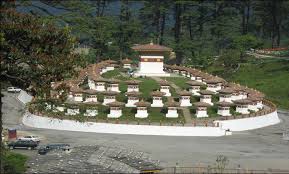 Dochula Pass: (3140m) The 108 chortens was built by the present Queen Mother of Bhutan Ashi Dorji Wangmo Wangchuck to commemorate Bhutan’s victory over Indian militants and to liberate the souls of the souls lost. From here we can view beautiful Bhutan Himalaya snow & mountain. At the same time can visit Druk Wangyel Lhakhang, inside can see images of fourth king battling rebels in the Jungle, monks with laptops and Druk airplane, alongside a modern history of the kingdom.
Dochula Pass: (3140m) The 108 chortens was built by the present Queen Mother of Bhutan Ashi Dorji Wangmo Wangchuck to commemorate Bhutan’s victory over Indian militants and to liberate the souls of the souls lost. From here we can view beautiful Bhutan Himalaya snow & mountain. At the same time can visit Druk Wangyel Lhakhang, inside can see images of fourth king battling rebels in the Jungle, monks with laptops and Druk airplane, alongside a modern history of the kingdom.
Lunch will served at lobesa cafeteria
Chimi Lhakhang
 After Lunch, short walk to Chimi Lhakhang.
After Lunch, short walk to Chimi Lhakhang.
ChimiLhakhang – On a hillock in the center of the valley below Metshina is the yellow-roofed ChimiLhakhang, built in 1499 by the cousin of Lama DrukpaKinley in his honor after he subdued the demoness of the nearby Dochula with his ‘magic thunderbolt of wisdom’. A wooden effigy of the Lama’s thunderbolt is preserved in the Lhakhang, and childless women go to the temple to receive a Wang (blessings) from the saint.
Punakha Dzong
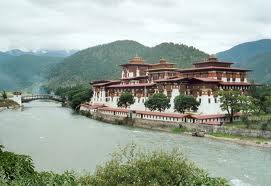 Punakha Dzong built and served as the capital and seat of government until Thimphu was promoted to the top job in the mid-1950s. Guru Rinpoche foretold the construction of Punakha dzong, predicting that ‘..a person named Namgyal will arrive at a hill that looks like an elephant’. When Zhabdrung visited Punakha he chose the tip of the trunk of the sleeping elephant at the confluence of the Mo Chhu and Pho Chhu as a place to build a dzong.
Punakha Dzong built and served as the capital and seat of government until Thimphu was promoted to the top job in the mid-1950s. Guru Rinpoche foretold the construction of Punakha dzong, predicting that ‘..a person named Namgyal will arrive at a hill that looks like an elephant’. When Zhabdrung visited Punakha he chose the tip of the trunk of the sleeping elephant at the confluence of the Mo Chhu and Pho Chhu as a place to build a dzong.
Night stay at hotel
Day -3, Punakha to Paro:
Khamsum Yulley Namgyal Chorten
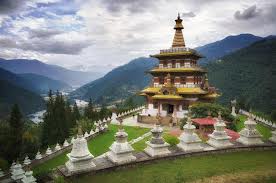 After breakfast, drive to Khamsum Yulley Namgyal Chorten is located 7 km north on Punakha, is the huge Khamsum Yulley Namgyal Chorten, perched high on a hill on the opposite bank of the river. The 30m-tall chorten (also known as the Nyzergang Lhakhang) took eight years to build and was consecrated in1999. The chorten is dedicated to the fifth king and serves to protect the country.
After breakfast, drive to Khamsum Yulley Namgyal Chorten is located 7 km north on Punakha, is the huge Khamsum Yulley Namgyal Chorten, perched high on a hill on the opposite bank of the river. The 30m-tall chorten (also known as the Nyzergang Lhakhang) took eight years to build and was consecrated in1999. The chorten is dedicated to the fifth king and serves to protect the country.
Simtokha Dzong
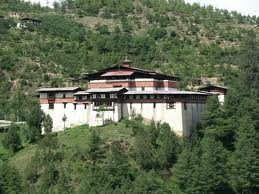 Onward journey to Paro via Dochula pass & Simtokha Dzong to Paro.
Onward journey to Paro via Dochula pass & Simtokha Dzong to Paro.
Simtokha Dzong – Five miles from Thimphu, on a lofty ridge, stands Simtokha Dzong the oldest fortress in the Kingdom, built by Zhabdrung Ngawang Namgyal in 1629 and it is said to be the 1st Dzong built in Bhutan. It was once attacked by the Tibetians and was repelled and the leader of coalition, Palden lama was killed. Later on the expansion and restoration was performed by the Third Druk Desi Mingyur Tenpa in 1670s.This site said to guard the demon that was vanished into the rock nearby hence it was named Simtokha, from simmo(demoness) and do (stone).
Lunch at Thimphu, after Lunch sightseeing at Paro valley and some the historical places:
Paro Dzong
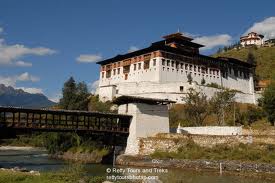 Paro Dzong also known as Rinpung Dzong, this 15th century massive fortress/monastery, is also the administrative center of the dzongkhag. The correct name of the dzong is Rinchen pung dzong but in short people call it Rinpung dzong meaning ‘fortress on a heap of jewels’. The dzong survived the 1897 earthquake but was severely damaged by fire in 1907. It was formerly the meeting hall for National Assembly both for monastic body as well as for the district government.
Paro Dzong also known as Rinpung Dzong, this 15th century massive fortress/monastery, is also the administrative center of the dzongkhag. The correct name of the dzong is Rinchen pung dzong but in short people call it Rinpung dzong meaning ‘fortress on a heap of jewels’. The dzong survived the 1897 earthquake but was severely damaged by fire in 1907. It was formerly the meeting hall for National Assembly both for monastic body as well as for the district government.
Evening just a walk around town’s Paro town and then dinner, Overnight at the hotel in Paro
Day-4, Hiking to Taksang Monastery:
Paro Taktsang Monastery
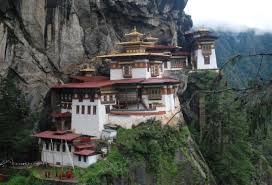 After good breakfast, we now move on for good exercise like hiking for Takshang Monastery (Tiger’s next monastery), that will be worth if you go for it.
After good breakfast, we now move on for good exercise like hiking for Takshang Monastery (Tiger’s next monastery), that will be worth if you go for it.
After breakfast, a 2-3 hours hike to the cafeteria is also a vantage view whereby you can enjoy the stunning view of the monastery. Prayer flags adorn the cliffs and this is also where Guru Padmasambhava landed on the back of a tigress in the 8th century. The place is named Takshang Goemba (Tiger’s Nest Monastery) as he flew to the site of the monastery on the back of the Tigress (a manifestation of his consort Yeshe Tsogyal) to subdue the local demon, Singye Samdrup. He then meditated in a cave here for three months. The site has long been recognized as a Ney (a holy place) and most of the people visit this monastery there during holidays and auspicious days to offer butter lamps.
Kyichu Lhakhang
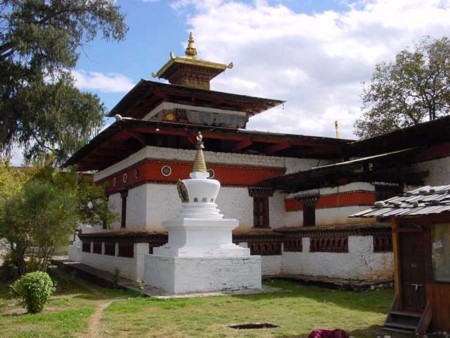 Kyichu Lhakhang (means temple) consists of twin temples. In the seventh century an event occurred that was decisive for Bhutan’s history: the Tibetan king Songtsen Gampo (619-649) erected the first Buddhist temples, the Kyichu-Lhakhang in Paro and the Jampe-Lhakhang in Bumthang. In 1968, H. M. Ashi Kesang, the Queen Mother of Bhutan, arranged for a second temple to be built alongside the first one, in same style. The Temple of Kyichu in the Paro valley is one of the most important shrines of Bhutan and the most sacred place for local people. It is an important place of pilgrimage and of ceremonies for the royal family
Kyichu Lhakhang (means temple) consists of twin temples. In the seventh century an event occurred that was decisive for Bhutan’s history: the Tibetan king Songtsen Gampo (619-649) erected the first Buddhist temples, the Kyichu-Lhakhang in Paro and the Jampe-Lhakhang in Bumthang. In 1968, H. M. Ashi Kesang, the Queen Mother of Bhutan, arranged for a second temple to be built alongside the first one, in same style. The Temple of Kyichu in the Paro valley is one of the most important shrines of Bhutan and the most sacred place for local people. It is an important place of pilgrimage and of ceremonies for the royal family
Kyichu Lhakhang, built in the 7th century by the Tibetan king, Songtsen Gampo, one among 108 Lhakhang built in a day.
Night stay at Hotel.
Day-5, Departure from Paro:
After breakfast, we will transfer to Paro airport and we bid a fond farewell to the Kingdom of Bhutan.
For more information and special price, please contact me at +977-980-335-3662, or e-mail at norbujig2014@gmail.com, or wechat id: jigmed8.
